Mortal Kombat: Deception E3 2004 Hands-On
We finally get to play the biggest and baddest MK yet.
We've been closely following Mortal Kombat: Deception since news of the game first hit earlier this year. The sixth entry in the venerable Mortal Kombat franchise continues the reinvigorated approach seen in 2002's Mortal Kombat: Deadly Alliance by presenting an impressive amount of new content. While the game will make its playable debut at E3 next week, we were lucky enough to have the opportunity to get an exclusive look at some of the content in the meaty demo Midway will be showing off on the show floor.
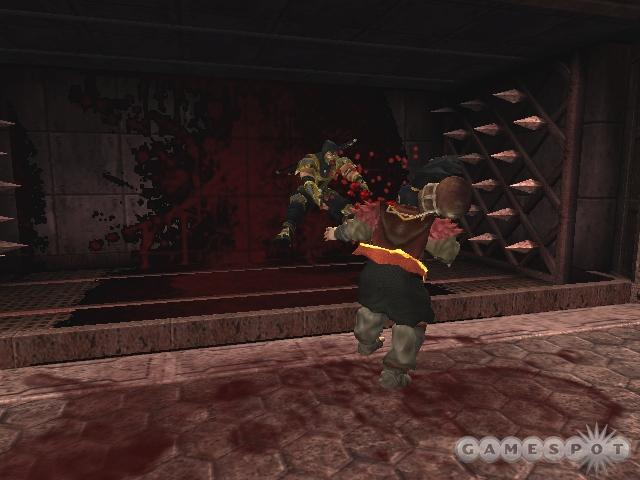
The work-in-progress version of the game features an impressive sampling of some of what the final game will offer. The first mode in the game we tried was the traditional fighting mode. The roster of available characters clocks in at 12 characters--roughly half of whom will appear in the final game. Old-timers Baraka, Nightwolf, Mileena, Sindel, Ermac, Sub-Zero, and Scorpion join Deadly Alliance's Li Mei, Kenshi, and Bo Rai Cho. All the characters' designs have had varying degrees of work done, resulting in slightly new looks for everyone. In addition to the old crew, newcomers Ashra (the Raiden-looking female seen briefly in the first trailer) and Hotaru (a male warrior sporting an elaborate suit of samurai-inspired armor) are on hand to brawl.
The demo features a sampling of playable backgrounds that you'll see in the final game. While all the backgrounds are totally new, they sport much more intricate design sensibilities than those seen in Deadly Alliance thanks to their multitiered layouts and interactive elements. Although we've seen snippets of most of them in action, they still pack a punch, since the clips shown haven't really done their designs justice. The level currently called The Netherbelly is set on a ship at sea, and it features corpses dangling from ropes at one end. Although the swaying corpses definitely add to the atmosphere, they're more than just ornamental. You'll actually be able to use them as you fight. Punching them will actually send them flying at your opponent. Depending on how the corpses are struck, the bodies' impacts will either dole out a modest amount of damage or knock your foe down. In addition, the level features railing you can knock your opponent through.
The Sky Temple is set on a roof during a rainstorm and features a few levels you can knock your enemies down through. In fact, a cinematic (à la DOA 3) shows them bouncing off the roof awnings on their ways down. The Red Dragon Temple is the stainglassed-heavy area seen in the latest trailers for the game, which feature examples of the environmental weapons you can get from breaking objects, such as glass shards. The Slaughterhouse is the nasty locale seen in the first trailer that features the fun-to-watch-but-unpleasant-to-experience meat-grinder stage fatality. Hell's Foundry is the factory-like setting that features a conveyor belt with a molten-metal stamping machine. The massive press serves as the stage's instrument of fatality. The losing fighter is thrown on molten metal and is then allowed to shriek in pain--while burning--right before the massive press comes down and reduces him or her to a bloody smear. The Beetle Lair is the multitier temple area we've seen in the trailers that features a heavy arachnid influence, with spider statues and web designs strewn throughout the area. However, our favorite arena is likely to be the currently unnamed platform that is in the process of falling apart during your battle. At the start of the battle, the arena is a pretty large oval, but every few seconds, a chunk of it will fall away. The reduced melee area keeps the fight pacing tight, which is very nice. In addition, the stage's fatality is represented by the time-honored MK staple of "knocking one's foe out of the arena and sending him or her plunging off of its side and down to the massive spikes of impalement below."
While the fighting system is still a work in progress, since the team is still balancing everything out, what's on hand offers a good idea of where things are headed. The basic combo and three-fighting-style systems are back but are enhanced by some significant additions. The fight-state indicator system lets you gain a better understanding of the flow of battle, because it lets you track your vulnerability and that of your foe. The indicator offers three color-coded warnings--red, blue and yellow--that let you know when you're open to attack during a battle. The system has been tweaked since our last look at the game to make the indicators less obtrusive on the screen. The meters for you and your opponent now appear under your health bars, as opposed to up the side of the left and right sides of the screen. Another addition to the game is marked by the return of the old-school uppercut, which is a comfortable amenity to have in a fighter's arsenal of common melee attacks.
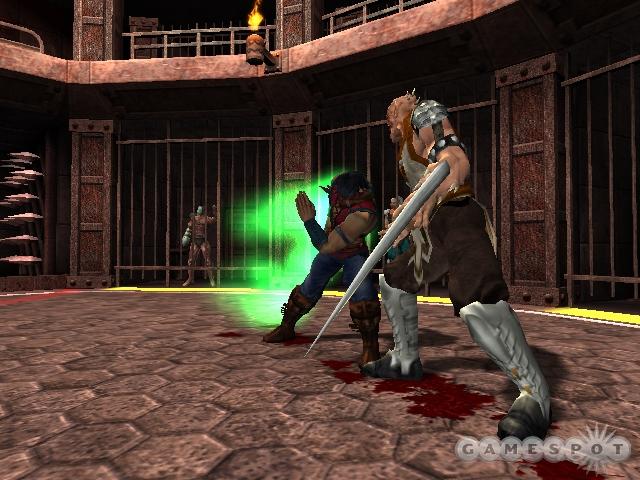
The characters' various special moves are a nice assortment of painful, flashy attacks that are easy to pull off. The returning old-school characters have some of their classic moves, although they've been tweaked a bit. For example, Nightwolf's energy arrows can now stick in an opponent and can slowly drain life over time. As for fatalities, the demo does have a handful of them. While we don't want to spoil their impacts, suffice it to say that the traditional Mortal Kombat macabre sensibilities are firmly on display. It's especially nice to see the sick "freshening" that's been done to the veteran characters' fatalities.
Overall, we have to say that, despite the fact that there haven't been any massive changes to the fighting system, combat feels significantly different. You really have to be conscious of a lot more during a fight. While your positioning has always been important, the fact that you can be backed into a death trap or knocked off a platform if you're not careful makes it vital that you pay attention to where you are in relation to your surroundings. Along these same lines, you'll find that you have to be keenly aware of what's around, because you don't want an opponent to grab the weapons that are strewn throughout the environment for use against you. Your powers of observation are especially important when players are knocked through the environment, because this occurrence potentially creates weapons that can be picked up and used. While some players may not pay much attention to the fight state indicators at first, it's likely that they'll come to respect and rely on the simple system, because it can definitely come in pretty handy.
The next part of the demo we tried was the original puzzle game. The puzzle game gives a highly addictive taste of the Puzzle Fighter-esque inspired mode. The demo's roster features superdeformed pint-sized versions of Mileena, Scorpion, Ermac, Kenshi, Sub-Zero, and Baraka. "Kombat" in this mode revolves around clearing colored blocks that fall into a playfield that dominates the top of the screen. Your minifighter faces off against his or her opponent in a small space at the bottom of the screen. Now, while the game draws aesthetic inspiration from Capcom's classic Puzzle Fighter game, its mechanics are more streamlined. Your main concern will be to remove the colored blocks from your field by using dragon icons of the same hue. Doing so will help fill your special fighter's special meter, and it will let him or her perform a unique special attack that has offensive or defensive uses. For example, Mileena can trigger a drill that clears out blocks, while Kenshi will raise the blocks on your opponent's playfield up a few levels.
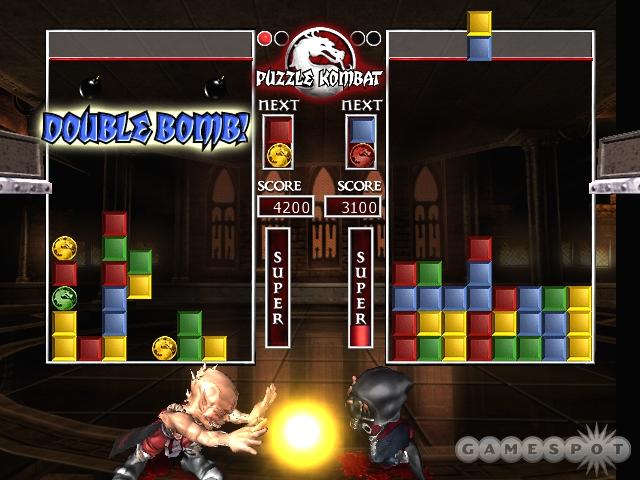
In addition to your character's special move, you'll be able to make use of bombs that will drop down along with the colored blocks. The mini-explosives will take out all blocks of the same color as the ones they land on. The mode even includes stage-specific fatalities. The demo features three locales from the proper fighter that have been made over to provide suitable 2D backgrounds for the ongoing pint-sized battles. You'll fight in a minifoundry (complete with presses on either side of the screen), the beetle lair, and yin yang beach.
While the gameplay doesn't feature the same amount of depth seen in Puzzle Fighter, which featured counters and insane combos, the core mechanics are solid. The simple and accessible gameplay helps keep the pacing of fights moving along at a good clip and lends itself to some white-knuckle moments. There's nothing more profanity-inducing than dutifully building up the mother of all multitier combos only to have your opponent drop blocks on your playfield or use a special move to hose the layout of the blocks on your playfield.
In keeping with the unorthodox use of the MK characters, our next stop was the chess game. The MK chess demo let us get a feel for the Archon-inspired turn-based offering that mixes a chess-style game with 3D combat. The game's basic structure lets you and your opponent trade off moving your forces around a board while engaging in arcade-style combat when you collide.
The goal of the game is to take out your opponent's leader with the assorted "pieces" at your disposal. Your pieces are fighters that you assign to one of five classes. The classes affect each character's attack and life stats, forcing you to be a little careful with how you deploy them. The "leader" is the equivalent of your king in standard chess. Your "champion" is essentially your queen and is the most mobile of your pieces. The "grunt" is your pawn, and it serves as cannon fodder. The last two classes, the sorcerer and shifter, don't have ties to traditional chess and are more in tune with MK sensibilities. You'll actually have two sorcerers--in good and evil flavors--who are able to cast spells. The good sorcerer will cast support magic that will let you heal, protect, and resurrect fallen pieces. Your less virtuous spellcaster will be able to do all the fun stuff, like instantly kill one of your opponent's pieces, teleport one of your pieces anywhere on the board, and sacrifice one piece to heal another. Before you think you can kick back and let your sorcerer's do all the work, you should know that you're only going to be able to cast these spells once over the course of a match, so you'll have to use your head. Finally, your shifter is a unique piece that transforms into an exact copy of his or her opponent. This actually makes for a good test of skills, because then you can see who knows how to play a specific character better.
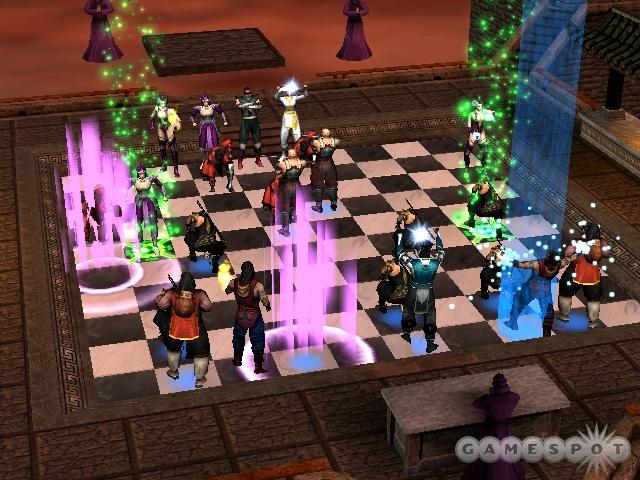
The core chess-style game is livened up by two unique types of squares that offer good and ill effects. You'll find two special squares on the board that will power up the pieces that land on them. The nasty catch to this is that the power-up bonus applies to any piece, so if you're on the square and your opponent attacks you, you both gain the bonus. The second type of square adds a good bit of unpredictable danger to the proceedings. At the start of each match, you and your opponent will be able to place one invisible bomb square on the board, which spells doom for any piece that lands on it. To help hide where you place the bomb when playing against a human opponent, the team has thrown in some misdirection. When laying your bomb, you have to move a cursor across the board in plain sight of your opponent. However, the game features a fake bomb button that will chime as though you've placed a bomb, making it difficult for your foe to know exactly where you've actually dropped it.
The game's presentation is a standard 3D chess-style grid, with all the pieces appearing as smaller versions of the fighters. The settings for the game offer a tip of the hat to Mortal Kombat's history and feature backgrounds based on arenas from Mortal Kombat and Mortal Kombat II. The demo features the monk temple from the original MK (complete with clapping monks) and the portal and death pool from MK II. The backgrounds serve double duty, since they are also the arenas you'll fight in when you clash with your foes.
The last component of the MK Deception demo we tried gave us a taste of the newly revamped Konquest mode. Whereas the Konquest mode in MK: Deadly Alliance was a linear run through various locations in Outworld, where you faced off against assorted enemies in battles with varying win conditions, the new mode is deeper and significantly bigger. This time out, you'll play through the life of a warrior from adolescence to geezer-hood in a free-roaming adventure that will send you through various Outworld realms. The demo we tried was just a small portion of the opening, which shows you starting out as a young'un who's making a way to Bo Rai Cho's school of martial arts. While you're locked into a specific chain of events at the start of the mode--to bring you up to speed on what's going on--after the introductions, you're free to go about your business however you choose.
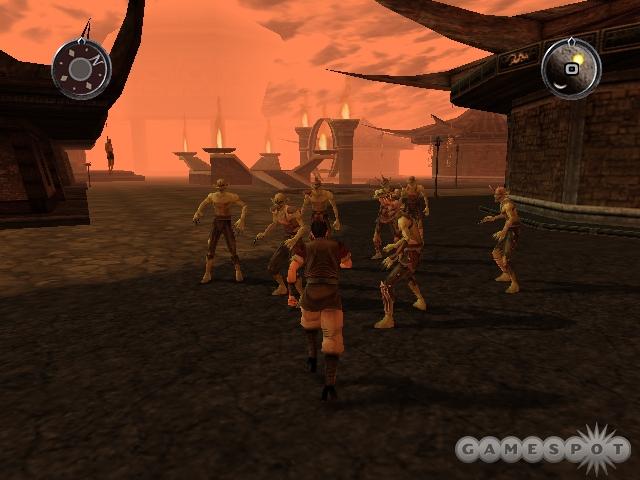
There's obviously a linear element to the mode, because you'll interact with key characters that will move the story forward. In the demo, a green aura was featured and pointed to your in-game compass. However, you can go through the tasks that the key characters assign you at your own pace. The early part of the mode finds you following one of Bo Rai Cho's students to different classrooms in the school to learn the basics of fighting (which is essentially a new spin on the tutorial in the original Konquest mode). If you choose to break from the pack to do your own thing, you'll discover there's a nice helping of side quests that will reward you with items, koins, and the like. For example, you'll meet a guard who will block your way in your travels. To pass him, you'll have to ask around for some ham that you can give to him so that he'll warm up to you.
When you do finally get around to completing the goals that will move the story forward, your character will start to age, and your character model will mature as you go. One of the coolest elements of the free-roaming mode is the environment that features a population of folk who are going about their business. You'll actually be able to talk to the characters you'll see, who will often offer tips for unlocking the plethora of secrets in the game. Whereas MK: Deadly Alliance used the Krypt mode to hide the bulk of the game's extras, MK: Deception is stocking up Konquest mode to be the premier place for getting the cool stuff. You'll see characters, such as Scorpion or Sub-Zero, in certain areas, but when you go to investigate, they'll disappear. Discovering how to find these characters--and the many others crammed into the mode--will be one of the many mysteries you'll have to solve. The key to catching some of the characters will lie in the game's time feature, which tracks the passage of time in the game. The game clock will track the day and time--in the gameworld--that you're playing. While it seems inconsequential, you'll find that location and date play a large part in finding some wickedly cool stuff. To help you get the right times and places down, the mode will feature a "meditation" function that will let you speed up time so you don't have to wait too long for something to come around. You'll notice that the day-and-night cycle in the game affects the environment, because the locals hightail it home when the sun goes down.
The graphics in the game are looking good on both platforms, and they improve on the visuals seen in Deadly Alliance. The character models are looking sharp, and the new makeovers we've seen for the fighters (so far) are suitably menacing. The interactive backgrounds are looking good and sport the MK style of design that's menacing and over-the-top. Aside from the fighting game, the superdeformed fighters in the puzzle game are well-done "Mini-Me's" of the main cast, who all feature some pretty funny fight animations. The chess game graphics are well done, with the standout touches being the 3D makeovers of the MK and MK II backgrounds. Additionally, the graphics in Konquest mode are coming together slowly but look pretty good nonetheless. The frame rate for the various modes is good and smooth, despite the fact that the graphics engine's overall performance has been bumped up considerably.
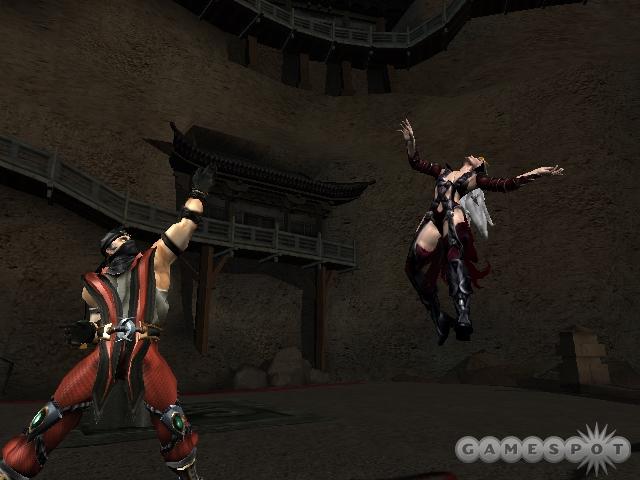
As far as audio goes, there's still quite a bit to be added to the game in terms of music and sound effects at this stage, but what's on hand is good. The various character voices are suitably melodramatic, and the music we've heard so far fits in well with the MK vibe. One of the nice sound touches we noticed was the surround support, which helps you keep track of your environment. For example, when you're playing in the Slaughterhouse, you can hear the meat grinder gnashing away even if you can't see it, which helps you keep tabs on where you are in relation to its deadly blades.
Based on what Midway's shown off so far, Mortal Kombat: Deception is well on its way toward improving on its predecessor in every aspect. The new modes are well-thought-out and are addictive enough to stand on their own. While everything we've talked about may sound like a lot, it really isn't (in the grand scheme of the game). If you factor in the ability to play the fighting, puzzle, and chess games online, in addition to the meaty quest in Konquest mode and the goods the team is hiding in the Krypt, there's still a lot to the game. And we didn't even mention the rest of the roster or backgrounds. Look for more on Mortal Kombat both from the E3 show floor next week and in the coming months. In the meantime, check out the game's media page for some brand-spanking-new footage, courtesy of Midway.
Got a news tip or want to contact us directly? Email news@gamespot.com
Join the conversation